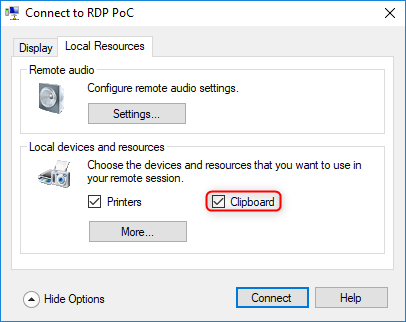
A vulnerability in Microsoft’s Remote Desktop Protocol (RDP) can also be used to escape virtual machines running on Hyper-V, the virtualization technology in Azure and Windows 10.
The bug is a path traversal that leads to remote execution and was reported to Microsoft almost a year ago as affecting only RDP and remained unpatched until recently, when it was discovered that it impacts Microsoft’s Hyper-V product.
Initially, Microsoft validated the finding but dismissed a fix motivating that it did “not meet our bar for servicing.”
Eyal Itkin from Check Point published in February the technical details about the flaw as part of a larger research that covered multiple RDP vulnerabilities. His focus was on achieving a reverse RDP attack, where the server of a remote connection gains control over the client.
This was possible because two machines connected through RDP share the clipboard, which means that whatever is copied on the remote server can be pasted on the local client.
RDP in Hyper-V virtual machines
A connection between virtualization and remote desktop technology is not immediately apparent, but in the case of Hyper-V, the former relies on the latter for increased functionality.
However, the Enhanced Session Mode in Hyper-V enables an RDP connection to virtual machines. This is used to share devices and files between the two systems.
With Enhanced Session Mode active, the relation between the two products becomes evident as the same settings window is available for both a Hyper-V virtual machine and a remote connection via Microsoft’s RDP client (mtsc.exe).

It also serves to synchronize clipboard content, and it is turned on by default. Itkin applied to the Hyper-V context the same proof-of-concept script that demonstrated the flaw in RDP and it worked the same.
In this case, though, the researcher achieved a guest-to-host virtual machine escape. In the PoC video below the researcher shows how simply pasting a file on the host connected to a malicious virtual machine enables the attacker to add a malicious file in the host’s Startup folder, thus ensuring execution at the next reboot.
Itkin told BleepingComputer that an attacker could use this vulnerability to compromise computers of privileged users in a company.
By forcing an administrator to connect to a computer or virtual machine under their control, an adversary can escalate the attack.
“Once someone connects to the computer using RDP, the attack starts. If the victim, the connecting client, issues a “paste” operation while the connection is open, even pasting on his computer, they are vulnerable. The attacker could use a vulnerability in the shared clipboard to drop arbitrary files to arbitrary locations on the target’s computer, effectively taking over it.” – Eyal Itkin
Presented with the new findings, Microsoft changed its initial stance and issued an identification number (CVE-2019-0887) for the vulnerability and a patch with July’s security updates.
“While it was hard for any security researcher to miss Microsoft’s effort to test and improve the security of its Hyper-V technology, we can learn an important lesson from this research. As the saying goes: your system is only as strong as its weakest link. In other words, by depending on other software libraries, Hyper-V Manager inherits all of the security vulnerability that are found in RDP, and in any other software library that it uses.”
If installing the latest updates is only possible at a later time, the researcher says that disabling the shared clipboard, which is on by default, neutralizes the vulnerability.
Details about the attack and the underlying flaw that enabled it are presented at the Black Hat USA security conference where Itkin and Dana Baril, security software engineer at Microsoft, talk from the perspective of both an attacker and a defender.
Related Articles:
Google’s Cloud IAP Now Generally Available for Cloud VM Clients
BlueKeep Warnings Pay Off, Boost Patching in Enterprise Networks
Microsoft Azure Bastion Preview: Remote VM Access via Azure Portal
Microsoft 365 Business Adds Granular Controls to Company Assets
Windows 10 Insider Build 18956 Brings the Always on Top Calculator
Bleeping Computer® is a community of individuals of all ages who are here to learn new information, to help each other, and to help their fellow peers. With that in mind, we ask that all members please follow these simple rules in order to create an atmosphere where everyone feels comfortable.
The rules are as follows:
- All information and instructions given within these forums is to be used at your own risk. By following or using any of this information you give up the right to hold BleepingComputer.com liable for any damages.
- All the forums are categorized by topics. Please post your questions or messages in the appropriate forum.
- Answers to many of the questions you may have can be found in the Tutorials Section, Glossary, or from other posts on the message boards. Please use the search functions, at the top right of each page, to find your answers. If you are still having problems, feel free to post your question.
- All help must be provided in the forums or on our Discord Server. We do not allow support to be provided or requested via personal message, email, or remote desktop control programs (Logmein, TeamViewer, etc).
- If a topic is posted in a forum that is not appropriate for the question, the staff has the right to move that topic to another better suited forum.
- The posting of any copyrighted material on our web site is strictly prohibited.
- Posting links in order to generate affiliate commissions is not permitted at BleepingComputer.com. Any posts that are deemed to be posted in order to generate affiliate commissions, regardless of the product being promoted, will be deleted. If a user continues to create affiliate SPAM posts, they will be banned.
- Posting links to non-Bleeping Computer malware removal guides is NOT permitted with the exception of security vendors who sometimes release specialized tools and instructional documentation. This is because it is impractical for BleepingComputer to monitor and review all such guides for accuracy, no matter how accurate those guides may, in fact, be.
- There will be no use of profanity on our message boards. This will not be tolerated and can lead to immediate suspension.
- When posting, please use proper grammar. Refrain from ‘text-message’ style substitutions of words like ‘u’ for ‘you’, and ‘ur’ for ‘your’. This is a multi-national forum, and some of our non-english speaking members must use translation software which is confused by abbreviations. Most of our volunteer members are very busy helping as many people as they can, and a post that is hard to read will often be overlooked.
- There will be no racial, ethnic, gender based insults or any other personal discriminations. This will not be tolerated and can lead to immediate suspension.
- There will be no posts meant to offend or hurt any other member, in a manner which is offensive or inflammatory. This includes flaming or instigating arguments.
- Spamming is not permitted; please keep all your posts as constructive as possible.
- Pornography, warez, or any other illegal transactions may NOT be linked in any shape or form.
- If you have questions regarding homework, we will only help you with general concepts. If you are looking for a complete solution or answer, we will most likely just delete your post.
- No subject matter will be allowed whose purpose is to defeat existing copyright or security measures. If a user persists and/or the activity is obviously illegal the staff reserves the right to remove such content and/or ban the user. This would also mean encouraging the use or continued use of pirated software is not permitted, and subject to the same consequences.
- If you are receiving assistance in the Virus Removal forum, you are not allowed to request assistance for the same computer at another malware removal forum. This is to prevent conflicting advice from causing issues with your computer or making it unbootable.
- This forum has the right to request alteration or deletion of any offensive post. If this is not done in a prompt manner, the Staff will delete the material themselves.
- Posts may be deleted for any reasons the forum administrators deem reasonable.
- Pictures may be posted as long as they are not explicit, offensive, or copyrighted.
- Advertisements, of any sort, are not permitted. This includes member names and links to commercial sites in Signatures, or in posts. You also may not solicit sales for Newegg through the use of promotion or coupon codes. If you would like to advertise on our site, contact us here.
- In order to reduce spam on the site, you will not be able to add a signature to your account until you reach 25 posts. Signatures are limited to 5 lines or 2000 characters; whichever comes first. If your signature is larger than the allotted size given or deemed unacceptable, you will be requested to adjust your signature. Failure to comply will result in the removal of your signature.
- Only one image per signature. Images in signatures must also be no larger than 500 pixels wide X 90 pixels high. If you have more than one image you will be requested to remove one. If this is not done in a timely manner the staff has the right to modify your signature to abide by these rules.
- Any links in signatures or profiles cannot be commercial in nature or they will be removed by BleepingComputer. You may not put links in your signature soliciting donations unless you are in certain member groups. Those member groups that are allowed will be expressly notified. If you have a personal website or off-site help resource, that is more than fine, but you can not sell products or services through your signature. Multiple links to the same site, unless for a very specific reason, are not permitted in a signature and will be removed.
- Avatars must be in good taste. This means no vulgar or violent images, pornography, or profanity. Avatars that are found to be inappropriate will be removed at the discretion of the staff.
- Linking to hate, anti-Semitic, racist, pornography, warez, or other illegal sites is not permitted.
- Links in your signature must be unobtrusive and can not use formatting so that attention is brought to them.
- Member’s display names can not be email addresses. This rule is in place to protect you from spam bots who will pick up your email address and spam you.
- Members may have only one account on this forum. There is no need to have more than one.
- Any impersonation of a user from these forums, in any mode of communication, is strictly prohibited and will result in a banning.
- Linked and locked topics are pruned regularly to reduce page clutter. If you have a question about where your topic went, please PM a Moderator or Administrator before starting a new topic asking where it went, or posting a duplicate of the original topic. We will be happy to provide you with a link to the new location, or a reason why it was locked and/or removed.
Violation of any of these rules can lead to a banning of the user from our Web Site and a deletion of their account. The consequences will be determined by the Staff on a case by case basis.
When posting you agree that the administrators and the moderators of this forum have the right to modify, delete, edit or close any topic, signature, account, or profile data at any time that they see fit. If you have any questions concerning this, please do not start a new thread, but rather private message to an administrator or moderator.